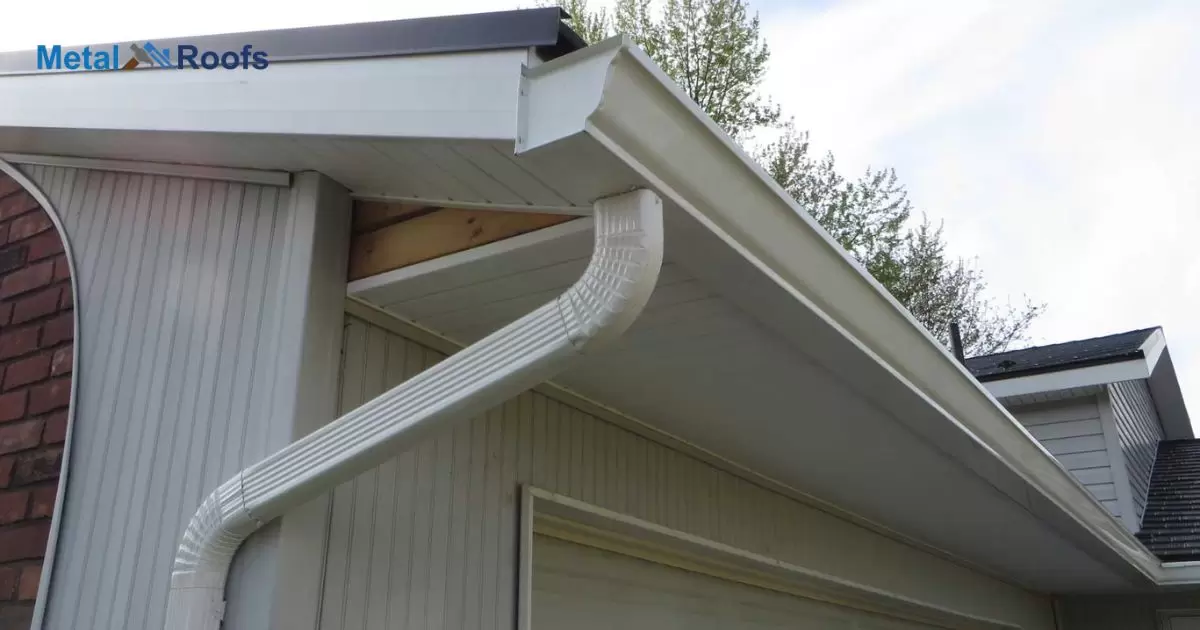First measure and mark where to place gutter brackets on the roof, uselag screws and washers to attach brackets, measure angles and cut gutter sections, connect gutter pieces with sealant and rivets, hang gutters from roof brackets, attach downspouts, and seal and caulk all joints to prevent leaks.
Installing gutters on a metal roof? First, measure twice, cut once. Proper placement of gutter brackets prevents future problems. Attaching with care keeps water flowing away from your home correctly. But most importantly, seal all seams thoroughly to prevent leaks in your new metal roof gutter system.
When installing gutters on a roof, consider the roof type, such as Gable Roof vs. Hip Roof, for precise measurements. Secure brackets firmly, cut accurate miters, and seal joints before riveting. Strategically attach downspouts to divert water away, accounting for the specific roof design.
Key Takeaways
- Use a chalk line to mark where gutters will be installed with proper slope.
- Attach gutter hangers every 2 feet along the roof edge using stainless steel screws.
- Join gutter sections, add end caps if needed, and secure downspouts.
- Use a level to confirm the gutters have a slight slope toward downspouts.
- Seal joints: Apply sealant to joints and end caps to prevent leaks.
- Run water through the gutters, making necessary adjustments for optimal performance.
- Ensure a well-installed gutter system for effective rainwater management on a metal roof.
Why Gutters are Important for Metal Roofing?
Gutters are important for metal roofing because they help to direct water away from the roof and prevent water damage. Without gutters, water can accumulate on the roof and cause leaks, rust, and other damage.
Types of Gutters for Metal Roofing
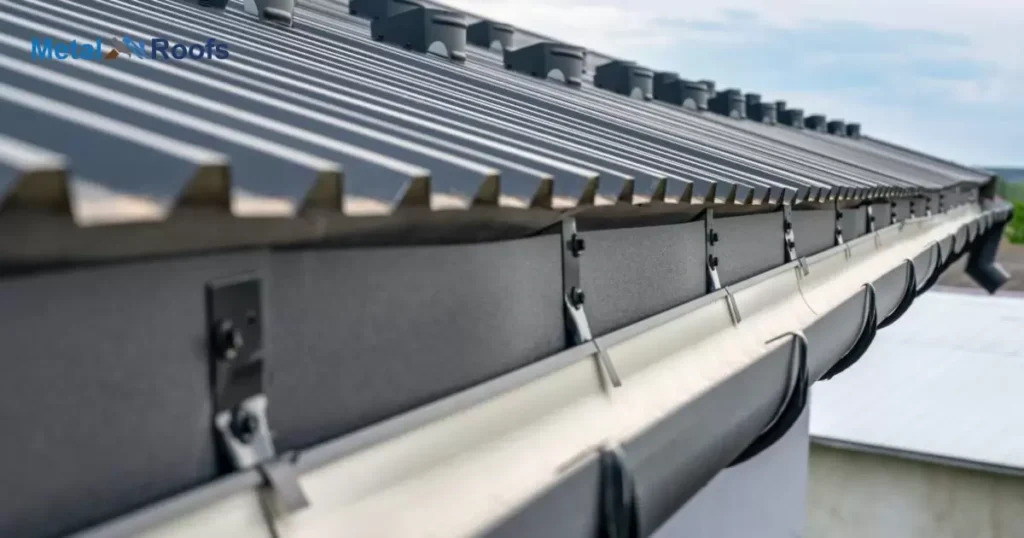
There are several types of gutters that can be used for metal roofing, including K-style gutters, half-round gutters, and box gutters. The type of gutter you choose will depend on your personal preference and the style of your home.
Materials Needed for Attaching Gutters to Metal Roofing
To attach gutters to metal roofing, you will need the following materials:
- Gutter sections
- Gutter hangers
- Screws
- Sealant
- Drill
- Tin snips
Step-by-Step Guide for Attaching Gutters to Metal Roofing
Here is a step-by-step guide on how to attach gutters to metal roofing:
Step 1: Measure and Cut Gutter Sections
Measure the length of the roof where you want to install the gutters and cut the gutter sections to the appropriate length using tin snips.
Step 2: Install Gutter Hangers
Install gutter hangers every 2 feet along the length of the roof. Use screws to attach the hangers to the roof.
Step 3: Attach Gutter Sections to Hangers
Attach the gutter sections to the hangers using screws. Make sure the gutter sections are level and sloping towards the downspout.
Step 4: Seal Joints and End Caps
Seal the joints between gutter sections and end caps using sealant to prevent leaks.
Step 5: Install Downspouts
Install downspouts at the end of the gutter system to direct water away from the roof and foundation.
What Exactly Are Gutters?
Gutters are metal or plastic channels attached along the edges of a roof. They catch rainwater and guide it away from the house to prevent water damage. Installed with a slight slope, gutters ensure efficient drainage towards downspouts.
These downspouts carry the water down and away from the foundation, protecting the structure from potential issues like basement flooding or erosion. Modernize a mansard roof with an updated gutter system to enhance both function and aesthetic appeal. In simple terms, gutters are like the rain’s traffic directors, keeping your home dry and foundation secure.
Common Issues With Gutters On A Metal Roof
| Common Issues | Recommendations |
| Improper drainage and spacing | Align gutters correctly, use recommended hangers, maintain proper slope (1/4 inch per 10 feet). |
| Leaks at joints and end caps | Thoroughly seal joints and end caps during installation. Regularly inspect and reseal potential leak-prone areas. |
| Sagging over time | Secure gutter hangers every 2 feet with stainless steel screws to prevent sagging. |
| Snow accumulation issues | Ensure gutters have a slight slope and sturdy hangers to prevent snow buildup. Test and adjust for proper slope. |
| Overall maintenance | Conduct regular checks and quick fixes to prevent minor issues from escalating. |
Installing gutters on a metal roof requires careful attention to avoid common issues. Improper slope and spacing can lead to water not draining correctly, causing potential damage. Ensure proper alignment with the roof edge and use the recommended hangers every 2 feet.
Overlooking the need for a sealant on joints and end caps can result in leaks. Water testing after installation is crucial to catch any problems early on. By following these steps, you can minimize common gutter issues and keep your metal roof well-protected.
Are There Alternatives To Gutters?
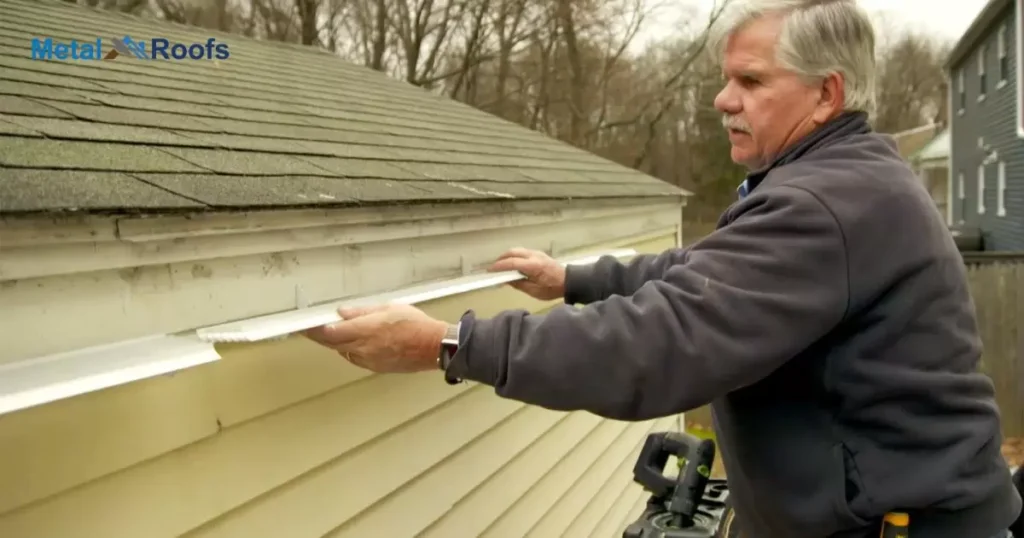
If you don’t want gutters, consider alternatives. One option is a rain diverter. It guides water away from the roof’s edge, protecting siding and preventing erosion.
Another choice is a splash block. It directs water from downspouts onto the ground, preventing soil damage. Choose what fits your needs, and enjoy a water-managed home without traditional gutters.
Gutters for Metal Roof And Snow
Metal roofs and snow can be a tricky combo. When installing gutters on a metal roof in snowy areas, make sure they have a slight slope about 1/4 inch per 10 feet – so the snow won’t pile up.
Use sturdy gutter hangers spaced every 2 feet along the roof edge. This provides solid support and prevents the weight of the snow from causing issues. Keep it simple: mark your line, attach hangers, connect gutters, and ensure a good slope. Test it out, and you’re all set for a winter-ready metal roof with reliable gutters.
Gutters on Metal Roof Problems
Metal roof gutters can face issues. If not properly installed, they may sag over time. To avoid this, secure gutter hangers every 2 feet along the roof’s edge with stainless steel screws.
Proper slope matters. Ensure a 1/4 inch per 10 feet slope for efficient drainage. Leaks often happen at joints and end caps. Seal them with the recommended sealant. Regular checks and a quick fix can save you from bigger problems later.
How To Attach Gutters To Metal Roofs Without?
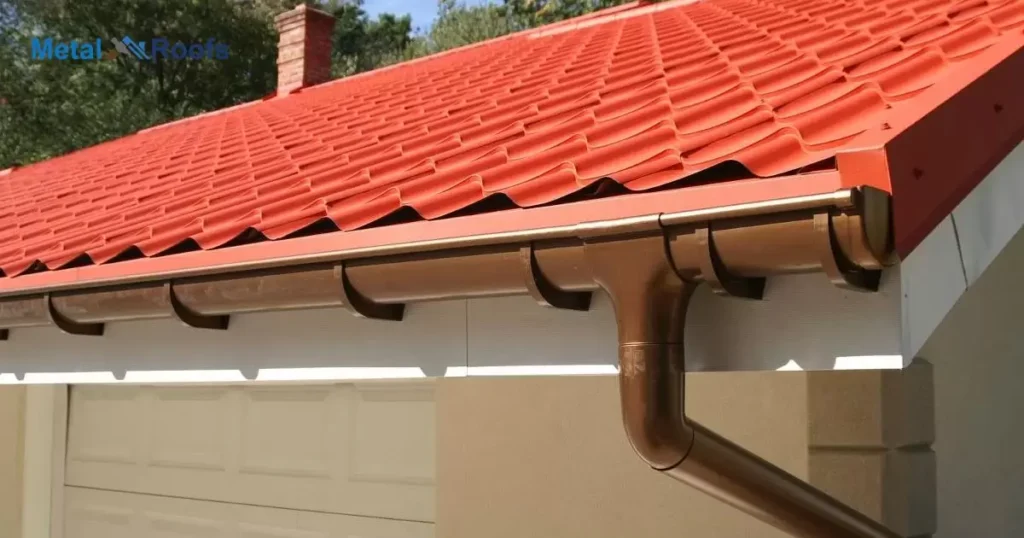
To attach gutters to metal roofs, first, measure and mark where the gutters will go. Use a chalk line for a straight guide. Secure gutter hangers with stainless steel screws every 2 feet along the roof edge, ensuring a slight slope for water drainage.
Connect gutter sections, add end caps if needed, and secure downspouts with brackets. Check the gutter slope with a level. Seal joints and end caps to prevent leaks. Test the system with water, making adjustments as necessary. A final inspection ensures a well-installed gutter system for effective rainwater management on your metal roof.
metal roof with gutters
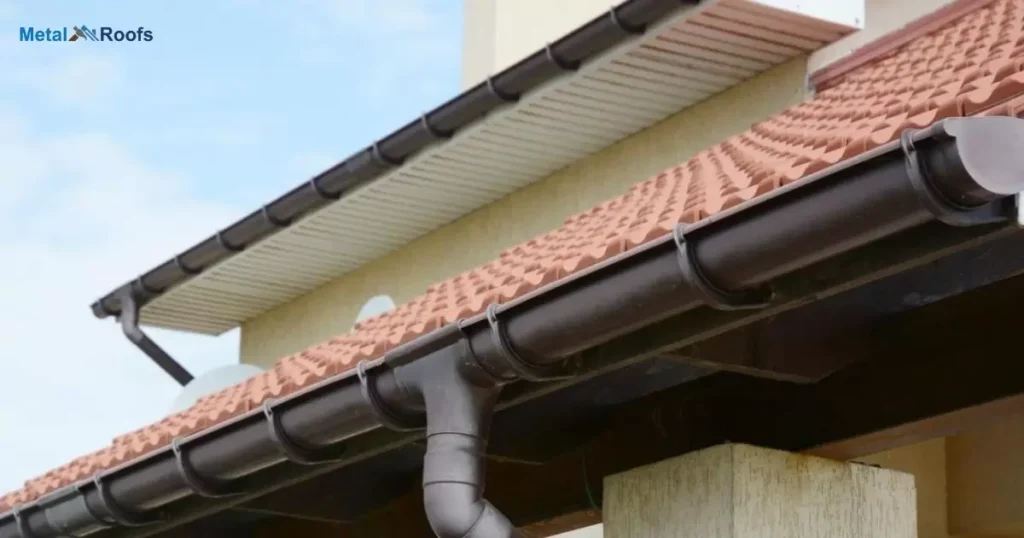
A metal roof with gutters offers durability and protection. It resists harsh weather and lasts for decades. The gutters channel rain away from the house. This prevents damage to walls and foundations.
Installation of gutters on metal roofs is simple. The gutters need regular cleaning to avoid clogs. Leaves and debris can cause overflow. Proper maintenance ensures long-lasting performance.
Frequently Asked Questions
Do metal roofs need special gutters?
Yes, metal roofs require specially designed gutters for effective water drainage and to prevent issues like corrosion. Standard gutters may not provide the durability needed for metal roofing.
What is the overhang for metal roof gutters?
The overhang for metal roof gutters is typically about 1 to 1.5 inches to allow proper water runoff without compromising the roof’s edge. This slight extension helps direct rainwater away from the building.
How do you install gutter guards on a metal roof?
Simply attach the gutter guards to the metal roof using screws. Ensure a secure fit to prevent debris accumulation and maintain effective gutter protection.
Conclusion
Attaching gutters to metal roofing is a straightforward process that can be completed by most DIYers. By following the steps outlined in this article, you can ensure that your gutters are properly installed and will provide the necessary protection for your metal roofing.
